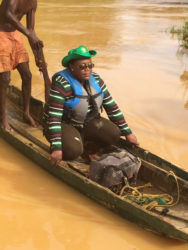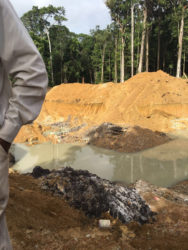The Facebook picture of Minister in the Ministry of Natural Resources and the Environment Simona Broomes balanced delicately in the middle of a decidedly vulnerable looking paddleboat, her hands extended on both sides, holding on to whatever she is able to grip as a boatman gingerly paddles her across the Konwaruk River, does much to communicate the risks that inhere in working in the mining sector.
Broomes was heading for the Konwaruk Backdam where she was to give a cease order for the mining operation that employed 18-year-old Ramal Williams, who was buried alive when a pit caved in. These days, crossing the river in small paddle boats is the accustomed way of getting to the area where the young miner lost his life.

“Men have died crossing that river,” Broomes said. “Sometimes it is in the dead of night and they are travelling alone.”
She conceded that from her vantage point the extent of the personal risk that she had taken might have been exaggerated by some of the comments appended to the photograph, given the fact that she had crossed the river before, as a miner rather than a minister, except that in those times she had to paddle herself, alone, across.
The Konwaruk River episode is a microcosm of a far wider range of risks and hazards that are par for the course in the mining sector and Broomes told the Stabroek Business in an interview earlier this week that “investment and commitment” were required to reduce the risks associated with working in the mining sector. “Making the industry safer for all the stakeholders really ought to be high on our list of priorities,” Broomes said.
She talked briefly about what has now become the monotonous regularity of mining accidents. Sometimes it seems that the collective propensity for taking risks that focus on the potential rewards outweighs regard for human life. This latest incident, she said was by no means the first time she had seen grown, hardy men traumatized after watching their colleagues disappear beneath mountains of sand.
She said that the trek to the Konwaruk Backdam including the risky trip across the river had reminded her that making the industry safer goes beyond the institution of on-site safety practices that prevent miners from being buried alive.
There is need, she said, for investment in a much broader range of physical infrastructure: roads, bridges, boats and airstrips, among other things, requisites which are costly but necessary. In the past, she said, there had been a far greater propensity for taking out of the gold-mining sector than for attending to its longer-term sustainability. “That is not something that we can afford any longer. The industry is far too important to the country’s economy,” she noted.
The limited collaboration between the Guyana Geology and Mines Commission (GGMC) and the Ministry of Public Infrastructure helps, though, given the vastness of the interior and the myriad deficiencies to be addressed, that collaboration can be compared with placing a succession of fillings in defective teeth.
She made the point that the vulnerability to the inhospitable conditions that obtain in the industry all too frequently confront unsuspecting coastlanders who hear the ‘El Dorado’ stories and straightaway assume the interior is a pushover. Some of them have paid a high price for their indifference.

It is the same, she said with the GGMC’s mines officers and engineers, mostly coastal creatures whose jobs require them to face the rigours of the interior. Sometimes, nothing in their formal training or their previous lives have prepared them for the experience.
Asked whether in her capacity as minister she ought to be required to take such risks, she declared, “It’s part of the job,” and that she prefers to manage “on the basis of facts.” Though one is left to ponder the wisdom of a minister of government being exposed to that kind of situation persistently.
“It is what you have to do if you are to be a miner,” she said. “It is part of the job.” But these days Broomes is the Minister in the Ministry of Natural Resources and the Environment and it is not unreasonable to wonder aloud as to whether it is not entirely unacceptable that she should be risked in that manner whenever a mission in a remote mining area comes up.
She made the point that the GGMC’s mines officers are perhaps even more vulnerable. At least, she said, she has done it all before. The rigors of the interior regions can easily get the better of coastlanders. Accordingly, she said, training for mines officers and the engineers must take account of the hazards of the interior. “The training has to go beyond their functions on the job. It is a matter of understanding the risks involved.”
Returning to the theme of creating an enabling environment that best allows for maximizing the resources of the mining sector, she said her own forays into the interior and her inevitable encounters with deplorable roads, unsafe bridges and risky waterways allow for a regime of reporting which helps central government to understand just where the stress points are in the overall infrastructure. Her recent trip to Konwaruk, she said, will result in more engagements with the Public Infrastructure Minister about rehabilitating roads and building bridges. “The (gold) industry,” she said, “is too big to be ignored.





